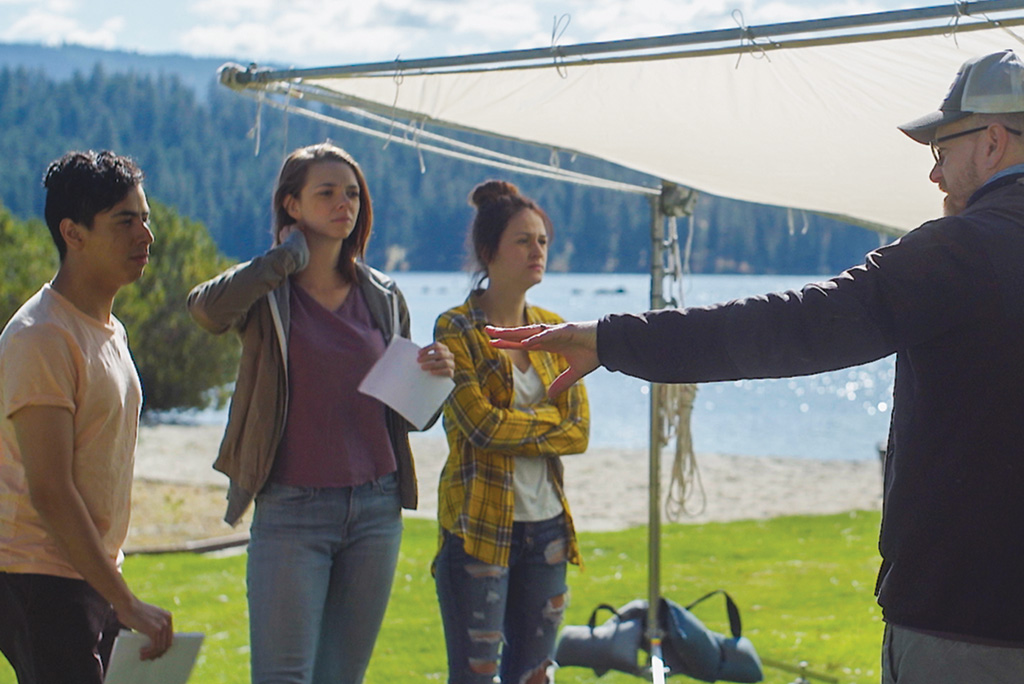A new film written and directed by and starring Idahoans recently debuted at the Boston SciFi Film Festival (a competitive festival that showed the first screening of Star Wars in 1979). Making Sense is an independent feature based on the science of neuroplasticity—the brain’s ability to rewire itself to compensate for a missing or diminished sense. Written and executive produced by Doug Cole and directed by Gregory Bayne, Making Sense was scheduled to air at the 2020 Sun Valley Film Festival but was cancelled due to COVID. After its positive reception in Boston (4.5 stars, tied for the highest rating at the Boston SciFi Film Festival), the film is now showing on Amazon, iTunes, Google Play, YouTube and video on demand.
The film follows an aging neuroscientist who teams up with a group of young graduate students to prove his hypothesis that individuals with disabilities hold the key to unlocking a sixth sense. People with disabilities representing the five senses (sight, hearing, taste, touch and smell) play roles with their respective diminished senses. Writer Doug Cole, who has lived in Idaho for 25 years, first became interested in the subject of neuroplasticity when several instances of disability affected him personally—his best friend Tom becoming paralyzed and paraplegic overnight, his nephew Noah being diagnosed with spina bifida and his best friend’s son being diagnosed with Down’s syndrome.
“Tom said, ‘I used to be the guy who looked at someone in a wheelchair with pity and averted my eyes, and now I’m the person who people can’t look at. I feel less than human.’ I thought, what if we could change that? What if we could put together the extraordinary things that people with disabilities can do and have that represented by the five senses? If you brought five people together with opposite senses, you’d have modern day X-Men in real life,” says Cole.
With this idea in mind, Cole began working on the script in his free time and doing research, particularly on Dr. Paul Bach-y-Rita, one of the early pioneers of neuroplasticity whom the doctor in the film is loosely based on. Bach-y-Rita developed the concept of sensory substitution in the 1960s to treat patients with disabilities. As the script progressed, Cole enlisted the help of the Idaho Council for the Deaf and Hard of Hearing, the Idaho School for the Deaf and Blind, the Idaho Commission for the Blind and Visually Impaired and others to ensure the script was plausible and represented people with disabilities in an authentic way.
Once Cole set his mind to turning his script into a film, he had three goals: keep the film in Idaho to the extent possible and hire Idaho filmmakers and talent, have people with disabilities in the script actually played by people with those disabilities, and to pay it forward.
“It was important to keep it Idaho-focused because creativity is universal; it cuts across disability, race, all of that. Yet it seems almost impossible sometimes to get a feature film produced unless you’ve got connections to LA. The people are already here—they’ve either migrated here or learned their craft elsewhere and moved here,” says Cole. Cole knew there was talent right in Idaho and he found that in Director Gregory Bayne, a director with two documentaries and a feature already under his belt and from Nampa to boot. Through word-of-mouth and an open casting call, Cole and Bayne found their actors with the represented disabilities and then filmed the entire movie between Boise and McCall.
In terms of paying it forward, Cole provided mentorship opportunities to Boise State film students looking to advance their careers. Cole also has a charity, IncludeAbility Inc., that he started before the film that raises money to promote inclusion of all abilities through youth sports, arts and other activities.
DISABILITY REPRESENTATION IN ENTERTAINMENT
† Approximately 20% of Americans have a visible or invisible disability.
† Only 2.7% of characters in the 100 highest-earning movies of 2016 were depicted with a disability.
† Among regular characters on primetime TV in the 2018-2019 season, only 2.1% had disabilities.
† Among disabled characters in the top 10 TV shows of March 2016, only 4.8% were played by actors who had that disability in real life.
† In the history of the Academy Awards, among the 61 Oscar nominees and 27 winners playing characters with a disability, only two were authentically portrayed by an actor with disability.
† 95% of top show characters with disabilities on TV are played by actors without disabilities.


